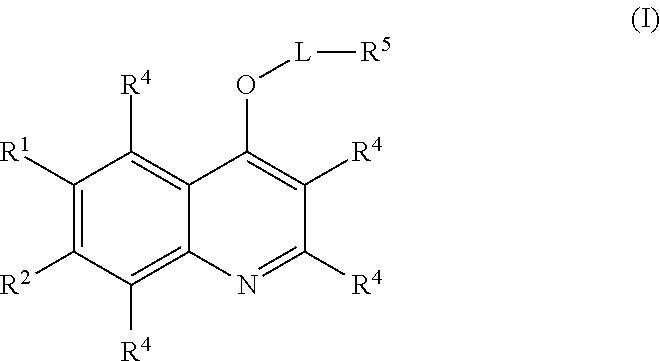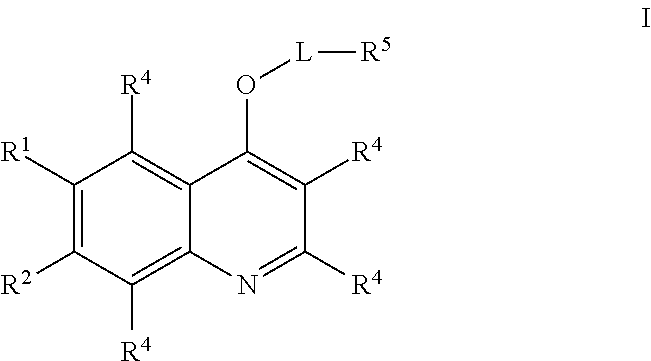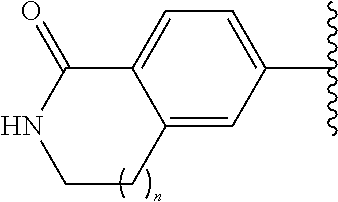Quinoline compounds and methods of use
a technology of quinoline compounds and compounds, applied in the field of quinoline compounds, can solve the problems of poor prognosis, overexpression of met and hgf,
- Summary
- Abstract
- Description
- Claims
- Application Information
AI Technical Summary
Benefits of technology
Problems solved by technology
Method used
Image
Examples
example 1
Preparation of 3-(3-fluoro-4-(6-methoxy-7-(3-morpholino-propoxy)quinolin-4-yloxy)phenyl)-5-methyl-6-(2-methylbenzyl)pyrimidin-4(3H)-one 101
[0209]
[0210]Step A: Preparation of 4-chloro-5-methyl-6-(2-methylbenzyl)pyrimidine: 2-Methylbenzylzinc chloride (25 ml of 0.5 M THF solution, 12 mmol) was added to a solution of 4,6-dichloro-5-methylpyrimidine (2.0 g, 12 mmol) and bis(triphenylphosphine) palladium(II) chloride (0.4 g. 0.6 mmol) in THF (20 mL). The reaction mixture was heated to reflux for 2 hours, cooled to room temperature, and then poured onto water (10 mL). The reaction mixture was extracted with ethyl acetate, and the organic layer was washed with brine, dried over sodium sulfate, filtered, and concentrated. The residue was purified by silica gel flash column chromatography (1:10 Et2O / Hexane) to yield the product (1.0 g, 35%) as a white solid. 1H NMR (CDCl3, 400 MHz) δ 8.75 (s, 1H), 7.09-7.22 (m, 4H), 6.84 (d, J=7.81 Hz, 1H), 4.15 (s, 1H), 2.38 (s, 3H), 2.32 (s, 3H).
[0211]Step...
example 2
Preparation of 6-benzyl-3-(3-fluoro-4-(6-methoxy-7-(3-morpholinopropoxy)quinolin-4-yloxy)phenyl)pyrimidin-4(3H)-one 102
[0215]
[0216]Step A: Preparation of 4-benzyl-6-chloropyrimidine: Prepared from 4,6-dichloropyrimidine (2.0 g, 13 mmol) and benzyl zinc chloride (0.5 M solution in THF, 27 mL, 13 mmol) according to the procedure described for Example 1, Step A. The crude product was purified by silica gel flash column chromatography (1:10 Et2O / Hexane) to yield the product (1.3 g, 47%) as a yellow liquid. 1H NMR (CDCl3, 400 MHz) δ 8.86 (s, 1H), 7.33-7.38 (m, 2H), 7.28-7.32 (m, 1H), 7.24-7.28 (m, 2H), 7.13 (d, J=0.78 Hz, 1H), 4.11 (s, 2H).
[0217]Step B: Preparation of 4-benzyl-6-(benzyloxy)pyrimidine: Prepared from 4-benzyl-6-chloropyrimidine (1.1 g, 5.4 mmol) according to the procedure described for Example 1, Step B. The crude was purified by silica gel flash column chromatography (1:1 Et2O / Hexane) to yield the product (1.3 g, 88%) as a colorless liquid. 1H NMR (CDCl3, 400 MHz) δ 8.76 ...
example 3
Preparation of 6-benzyl-3-(3-fluoro-4-(6-methoxy-7-(3-morpholinopropoxy)quinolin-4-yloxy)phenyl)-5-methylpyrimidin-4(3H)-one 103
[0221]
[0222]Step A: Preparation of 4-benzyl-6-chloro-5-methylpyrimidine: Prepared from benzyl zinc bromide (0.5 M solution in THF, 25 mL, 12 mmol) and 4,6-dichloro-5-methylpyrimidine (2.0 g, 12 mmol) according to the procedure described for Example 1, Step A. The crude was purified by silica gel flash column chromatography (1:5 EtOAc / Hexane) to yield the product (0.86 g, 32%) as a colorless oil. 1H NMR (CDCl3, 400 MHz) δ 8.78 (s, 1H), 7.28-7.33 (m, 2H), 7.18-7.26 (m, 3H), 4.19 (s, 2H), 2.35 (s, 3H).
[0223]Step B: Preparation of 4-benzyl-6-(benzyloxy)-5-methylpyrimidine: Prepared from 4-benzyl-6-chloro-5-methylpyrimidine (0.8 g, 4.0 mmol) according to the procedure described for Example 1, Step B. The crude product was purified by silica gel flash column chromatography (1:9 Et2O / Hexane) to yield the product (1.0 g, 94%) as a colorless oil. 1H NMR (CDCl3, 400 ...
PUM
| Property | Measurement | Unit |
|---|---|---|
| temperature | aaaaa | aaaaa |
| temperature | aaaaa | aaaaa |
| pH | aaaaa | aaaaa |
Abstract
Description
Claims
Application Information
 Login to View More
Login to View More - R&D
- Intellectual Property
- Life Sciences
- Materials
- Tech Scout
- Unparalleled Data Quality
- Higher Quality Content
- 60% Fewer Hallucinations
Browse by: Latest US Patents, China's latest patents, Technical Efficacy Thesaurus, Application Domain, Technology Topic, Popular Technical Reports.
© 2025 PatSnap. All rights reserved.Legal|Privacy policy|Modern Slavery Act Transparency Statement|Sitemap|About US| Contact US: help@patsnap.com



